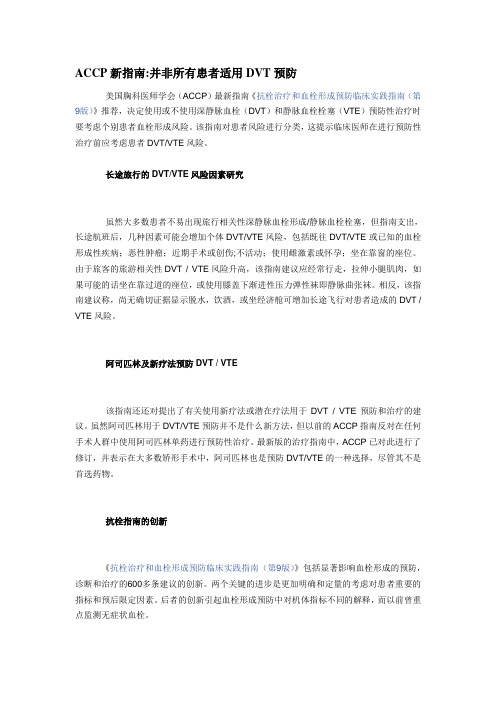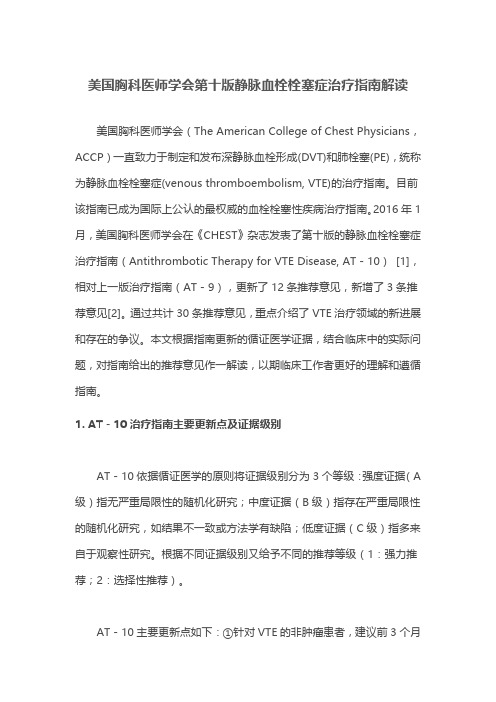美国深静脉血栓指南
- 格式:ppt
- 大小:188.50 KB
- 文档页数:6

ACCP新指南:并非所有患者适用DVT预防美国胸科医师学会(ACCP)最新指南《抗栓治疗和血栓形成预防临床实践指南(第9版)》推荐,决定使用或不使用深静脉血栓(DVT)和静脉血栓栓塞(VTE)预防性治疗时要考虑个别患者血栓形成风险。
该指南对患者风险进行分类,这提示临床医师在进行预防性治疗前应考虑患者DVT/VTE风险。
长途旅行的DVT/VTE风险因素研究虽然大多数患者不易出现旅行相关性深静脉血栓形成/静脉血栓栓塞,但指南支出,长途航班后,几种因素可能会增加个体DVT/VTE风险,包括既往DVT/VTE或已知的血栓形成性疾病;恶性肿瘤;近期手术或创伤;不活动;使用雌激素或怀孕;坐在靠窗的座位。
由于旅客的旅游相关性DVT / VTE风险升高,该指南建议应经常行走,拉伸小腿肌肉,如果可能的话坐在靠过道的座位,或使用膝盖下渐进性压力弹性袜即静脉曲张袜。
相反,该指南建议称,尚无确切证据显示脱水,饮酒,或坐经济舱可增加长途飞行对患者造成的DVT / VTE风险。
阿司匹林及新疗法预防DVT / VTE该指南还还对提出了有关使用新疗法或潜在疗法用于DVT / VTE预防和治疗的建议。
虽然阿司匹林用于DVT/VTE预防并不是什么新方法,但以前的ACCP指南反对在任何手术人群中使用阿司匹林单药进行预防性治疗。
最新版的治疗指南中,ACCP已对此进行了修订,并表示在大多数矫形手术中,阿司匹林也是预防DVT/VTE的一种选择,尽管其不是首选药物。
抗栓指南的创新《抗栓治疗和血栓形成预防临床实践指南(第9版)》包括显著影响血栓形成的预防,诊断和治疗的600多条建议的创新。
两个关键的进步是更加明确和定量的考虑对患者重要的指标和预后限定因素。
后者的创新引起血栓形成预防中对机体指标不同的解释,而以前曾重点监测无症状血栓。
资料来源:New Guidelines Suggest DVT Prophylaxis not Appropriate for All Patients.美国胸科医师学会,2012/02/07全文:New Guidelines Suggest DVT Prophylaxis not Appropriate for All PatientsArticle | 02.07.12(NORTHBROOK, IL, FEBRUARY 7, 2012) — New evidence-based guidelines from the American College of Chest Physicians (ACCP) recommend considering individual patients’risk of thrombosis when deciding for or against the use of preventive therapies for deep vein thrombosis (DVT) and venous thromboembolism (VTE). Specifically, the Antithrombotic Therapy and Prevention of Thrombosis, 9th ed: American College of Chest Physicians Evidence-Based Clinical Practice Guidelines, published in the February issue of the journal CHEST, focus on risk stratification of patients, suggesting clinicians should consider a patient’s risk for DVT/VTE and risk for bleeding before administering or prescribing a prevention therapy.“There has been a significant push in health care to administer DVT prevention for every patient, regardless of risk. As a result, many patients are receiving unnecessary therapies that provide little benefit and could have adverse effects,”said Guidelines Panel Chair Gordon Guyatt, MD, FCCP, Department of Medicine, McMaster University Faculty of Health Sciences, Hamilton, Ontario, Canada. “The decision to administer DVT prevention therapy should be based on the patients’risk and the benefits of prevention or treatment.” To address this, the ACCP guidelines provide comprehensive risk stratification recommendations for most major clinical areas, including medical, nonorthopedic surgery, orthopedic surgery, pregnancy, cardiovascular disease, atrial fibrillation, stroke, pediatrics, and long-distance travel.DVT/VTE Risk Factors for Long-distance TravelAlthough developing a travel-related DVT/VTE is unlikely in most cases, the guidelines note that for long-distance flights, several factors may increase an individual’s risk of developing a DVT/VTE, including previous DVT/VTE or known thrombophilic disorder; malignancy; recent surgery or trauma; immobility; estrogen use or pregnancy; and sitting in a window seat. For travelers with an increased risk for travel-related DVT/VTE, the guidelines recommend frequent ambulation, calf muscle stretching, sitting in an aisle seat if possible, or the use of below-knee graduated compression stockings. Conversely, the guidelines suggest there is no definitive evidence to support that dehydration, alcohol intake, or sitting in economy class increases a patient’s risk for developing a DVT/VTE resulting from long-distance flights. Aspirin and New Therapies for DVT/VTE PreventionThe guidelines also provide recommendations related to the use of new or potential therapies for the prevention and treatment of DVT/VTE. Although aspirin is not a new therapy for the prevention of DVT/VTE, previous ACCP guidelines recommended against using aspirin as the single agent for prophylaxis in any surgical population. In the current edition, the ACCP has revised this recommendation and indicates aspirin is an option—although not typically the agent of choice—for the prevention of DVT/VTE in major orthopedic surgery.“Although we are not recommending aspirin as the optimal DVT/VTE prophylaxis, we have reviewed the existing evidence and concluded that aspirin is an acceptable option in some instances where preventive therapy is needed,”said guideline co-author Mark Crowther, MD, Department of Medicine, McMaster University, Hamilton, Ontario, Canada. In regard to new oral anticoagulants, guideline authors recognize the recent clinical trials of apixaban and rivaroxaban, both direct factor Xa inhibitors, and dabigatran etexilate, a direct thrombin inhibitor, and offer recommendations for the new agents for select clinical conditions, including atrial fibrillation and orthopedic surgery.Innovations in Antithrombotic GuidelinesThe Antithrombotic Therapy and Prevention of Thrombosis, 9th ed: American College of Chest Physicians Evidence-Based Clinical Practice Guidelines include innovations that have significantly impacted the more than 600 recommendations for the prevention, diagnosis, and treatment of thrombosis. Two key advances are the more explicit and quantitative consideration of patient values and preferences and restriction of outcomes to only those deemed to be important for the patient. The latter innovation results in different interpretation of the body of evidence in thrombosis prevention that has previously focused on the detection of asymptomatic thrombosis by surveillance methods.Guideline authors also took a more critical look at the overall process of guideline development, providing more methodologically sophisticated scrutiny of all available evidence. “The evidence review for the new guidelines was more rigorous than ever before, and our method for grading research studies has become even more stringent,”said guideline co-author David Gutterman, MD, FCCP, ACCP Immediate Past President, Cardiovascular Research Center, Medical College of Wisconsin, Milwaukee, Wisconsin. “We believe that the objective rigorous application of the science of guideline development will ultimately best serve our patients.”The guidelines are endorsed by the following medical associations: the American Association for Clinical Chemistry, American College of Clinical Pharmacy, American Society of Health-System Pharmacists, American Society of Hematology, International Society of Thrombosis and Hemostasis, and the American College of Obstetrics and Gynecology (pregnancy article only).For more information about the guidelines and accompanying clinician resources, visit and follow #AT9 on Twitter. Patient resources related to the guidelines are available through OneBreath®, an initiative of The CHEST Foundation, the philanthropic arm of the ACCP.About the American College of Chest PhysiciansThe ACCP represents 18,400 members who provide patient care in the areas of pulmonary, critical care, and sleep medicine in the United States and more than 100 countries throughout the world. The mission of the ACCP is to promote the prevention, diagnosis, and treatment of chest diseases through education, communication, and research. CHEST is the official peer-reviewed publication of the ACCP. More than 30,000 readers worldwide turn to CHEST in print and 400,000 people view CHEST online each month for the latest in chest-related medicine. For more information about the ACCP, visit or follow the ACCP via social media at /accpchest and @accpchest.。

美国胸科医师学会第十版静脉血栓栓塞症治疗指南解读美国胸科医师学会(The American College of Chest Physicians,ACCP)一直致力于制定和发布深静脉血栓形成(DVT)和肺栓塞(PE),统称为静脉血栓栓塞症(venous thromboembolism, VTE)的治疗指南。
目前该指南已成为国际上公认的最权威的血栓栓塞性疾病治疗指南。
2016年1月,美国胸科医师学会在《CHEST》杂志发表了第十版的静脉血栓栓塞症治疗指南(Antithrombotic Therapy for VTE Disease, AT-10)[1],相对上一版治疗指南(AT-9),更新了12条推荐意见,新增了3条推荐意见[2]。
通过共计30条推荐意见,重点介绍了VTE治疗领域的新进展和存在的争议。
本文根据指南更新的循证医学证据,结合临床中的实际问题,对指南给出的推荐意见作一解读,以期临床工作者更好的理解和遵循指南。
1. AT-10治疗指南主要更新点及证据级别AT-10依据循证医学的原则将证据级别分为3个等级:强度证据(A 级)指无严重局限性的随机化研究;中度证据(B级)指存在严重局限性的随机化研究,如结果不一致或方法学有缺陷;低度证据(C级)指多来自于观察性研究。
根据不同证据级别又给予不同的推荐等级(1:强力推荐;2:选择性推荐)。
AT-10主要更新点如下:①针对VTE的非肿瘤患者,建议前3个月及以后使用达比加群、利伐沙班、阿哌沙班或依度沙班,优于使用维生素K拮抗剂(vitamin K antagonist, VKA)(2B级);更优于使用低分子肝素(low molecular weight heparin, LMWH)(2C级)。
②针对VTE 的肿瘤患者,建议使用LMWH,优于使用VKA(2B级)或是达比加群、利伐沙班、阿哌沙班或依度沙班(2C级)。
③对于VTE患者进行抗凝治疗,不推荐使用下腔静脉滤器(1B级)。

美国医师学会静脉血栓栓塞性疾病诊疗指南解读美国医师学会和美国家庭医师委员会近期公布静脉血栓栓塞性疾病(VTE )的诊断和治疗的临床指南。
该指南的目的是总结现有的证据,主要是针对初级医疗保健人员提供治疗DVT 和PE 的合理建议,帮助临床医师理解和应用不同的诊断工具,如D-Dimer 和超声,以及识别高危的临床特征。
VTE 包括下肢深静脉血栓(DVT )和肺栓塞(PE )。
根据美国的资料,每年发生的VTE 约60万例,因漏诊没有得到治疗的患者中,26%将发生致命性血栓事件,还有26%的患者再次发生非致命性血栓事件而最终致死。
存在于膝以上的血栓易合并PE ,小腿部的血栓发生PE 的风险较低,但有可能发生血栓后综合征。
因此,应重视早期诊断,做好预防工作非常重要。
一、临床诊断1.临床预测VTE 可能性的方法由于单纯应用个体的临床特征诊断VTE 的准确性较差,指南推荐应用有效的预测方法估计VTE 的危险性,并以此作为进一步采用其他实验室和影像学方法的根据,或解释其他检查结果的基础。
迄今为止,多个临床研究证实了Wells 预测法的有效性(见表1和表2)。
但应注意,没有并发疾病年龄较小者和有VTE 病史的患者应用Wells 预测法的预测价值较高。
老年人或合并疾病较多的患者最好结合临床判断。
表1 WELLS 深静脉血栓的临床评分临床可能性:低度≤0;中度,1~2分;高度,≥3。
若双侧下肢均有症状,以症状严重的一侧为准。
表2 WELLS 肺栓塞的临床评分临床可能性:低度,0~1;中度,2~6分;高度,≥7。
2.联合应用D-dimer和Wells评价法DVT风险低、D-dimer阴性的患者在3个月内 DVT的发生率仅为0.5%,临床上无需再做进一步的影像学检查。
DVT的可能性为中度和高度但D-dimer为阴性的患者3个月DVT的发生率分别为3.5%和21.4%。
D-dimer对于没有合并疾病、年龄较小的患者,或无VTE病史,或症状持续时间短的患者的阴性预测值最高。

深静脉血栓指南 ACCP指南解读1. 前言深静脉血栓(Deep Vein Thrombosis, DVT)是指血液在深静脉内不正常地凝结,形成血栓,常见于腿部。
如果不及时诊断和治疗,可能会引发肺栓塞等严重并发症。
为了提高临床医生对DVT的诊断和治疗水平,美国胸科学会(American College of Chest Physicians, ACCP)发布了深静脉血栓指南,为临床实践提供依据。
本文将对抗凝治疗部分的ACCP指南进行解读。
2. ACCP指南解读2.1 抗凝治疗适应症ACCP指南建议对以下患者进行抗凝治疗:•急性DVT患者•慢性DVT患者•肺栓塞患者•易栓症患者•抗凝治疗预防复发性DVT患者2.2 抗凝药物选择ACCP指南推荐使用以下抗凝药物:•维生素K拮抗剂(如华法林)•直接口服抗凝药物(如利伐沙班、阿哌沙班、达比加群)•凝血酶抑制剂(如尿激酶、重组组织型纤维蛋白溶酶原激活剂)2.3 抗凝治疗剂量ACCP指南建议根据患者的体重、年龄、肝肾功能等因素调整抗凝药物剂量。
具体剂量请参考相关药物说明书或专业指南。
2.4 抗凝治疗时长ACCP指南建议:•急性DVT患者抗凝治疗时长为3-6个月•复发性DVT患者抗凝治疗时长为6个月其他•预防复发性DVT患者抗凝治疗时长为6个月其他,根据患者情况可延长至12个月或更长时间2.5 抗凝治疗监测ACCP指南建议:•定期监测维生素K拮抗剂(华法林)患者的国际标准化比率(INR)•使用直接口服抗凝药物的患者无需常规监测•凝血酶抑制剂患者需根据药物特点进行监测3. 总结深静脉血栓(DVT)是一种常见的血管疾病,抗凝治疗是DVT患者的重要治疗手段。
ACCP指南为临床医生提供了关于抗凝治疗的适应症、药物选择、剂量调整、治疗时长和监测等方面的建议。
遵循指南,合理使用抗凝药物,有助于提高DVT患者的治疗效果,降低并发症发生风险。
本文为Markdown文本格式输出,内容仅供参考。

2016美国胸科医师学院(ACCP)新版静脉血栓栓塞症抗栓治疗指南解读(三)重磅消息:AT10循证指南2016年元月Online发表,链接请见/article.aspx?articleid=2479255深静脉血栓形成(DVT)与肺栓塞(PE)的抗凝疗程:包括初始治疗后的长期抗凝(3个月)与延展期抗凝治疗(无既定终止时间)的选择。
一、初始治疗后的长期抗凝疗程1. 对于近端DVT或PE患者,建议长期抗凝(3个月);优于不按照此方案进行抗凝治疗(1B级)。
作者解读:但是根据目前的临床经验,3个月疗程对很多患者并不足以防治复发,因此建议在抗凝满三个月后结合临床进行充分评估。
2. 对于存在下肢DVT或PE患者,如果不是肿瘤者,长期抗凝(前3个月)推荐应用达比加群、利伐沙班、阿哌沙班或依度沙班,优于VKA(2B级)。
若不使用达比加群、利伐沙班、阿哌沙班或依度沙班,建议应用VKA(2C级)。
备注:使用达比加群及依度沙班时,需要提前起始治疗选择胃肠外抗凝治疗,如低分子肝素,普通肝素等;而使用利伐沙班及阿哌沙班时不需要,但是需要初始治疗有负荷剂量;而选择VKA治疗时一定需要在前期与胃肠外抗凝药物重叠。
3. 对于同时存在下肢DVT或PE患者,如果合并恶性肿瘤,或称肿瘤相关血栓形成,长期抗凝(前3个月)推荐LMWH,优于VKA治疗(2C级)和新型抗凝药物如达比加群(2C级)、利伐沙班(2C 级)、阿哌沙班(2C级)、依度沙班(2C级)。
4.下肢DVT或PE接受延展期抗凝治疗者,推荐3个月后无需更换抗凝药物(2C级)。
备注:当患者临床状况或用药喜好变更时,抗凝方案选择可以做出相应调整。
二、不同情况下的抗凝疗程1. 与手术因素相关的下肢近段DVT或PE患者,推荐进行3个月的抗凝治疗,优于(i)较短时间抗凝(1B级);(ii)更长疗程的抗凝(如6或12个月)(1B级);(iii)延长抗凝治疗(1B级)。
2. 由非手术的暂时性风险因素导致的下肢近段DVT或PE患者,推荐3个月的抗凝治疗,优于(i)更短时间抗凝(1B级);(ii)更长疗程的抗凝(如,6或12个月)(1B级)。

美国外科医生学会抗血栓药物围手术期治疗指南人口的老龄化以及慢性病的治疗进展,增加了普通外科手术患者的医疗复杂性。
目前,约有十分之一的外科手术患者需要接受长期抗凝治疗。
(1)此外,在经皮冠状动脉介入治疗后,通常采用双重抗血小板药物对心肌梗塞和支架血栓形成进行二级预防。
这些合并症的围手术期管理具有挑战性,因为中断会暂时增加血栓栓塞的风险,而继续治疗会增加手术出血的风险。
平衡围手术期这些风险的临床后果至关重要,因为这会对发病率和死亡率产生不利影响。
(2,3)近年来,新型抗血栓药的涌入使外科医生难以及时掌握治疗方法。
尽管如此,外科医生还是有责任确保在围手术期适当管理患者的抗栓药物。
直接口服抗凝剂(DOAC)是一类相对较新的抗凝剂,已获得美国食品和药物管理局(FDA)的批准,可用于治疗非瓣膜性房颤患者的深静脉血栓形成(DVT)和肺栓塞(PE)以及预防血栓栓塞颤动。
与替代品(华法林)相比,DOAC具有更可预测的药理特性,起效快,半衰期短,并且不需要常规实验室监测。
这样,越来越多的患者被处方开具手术状态的DOAC。
开处方的医生和患者都被可预测的药理所吸引,从而无需进行常规实验室测试。
但是,由于只有一种药物(达比加群)具有FDA批准的逆转剂(依达珠单抗)且没有广泛可利用的血液,因此围手术期管理已被证明是困难的在开始进行手术之前,适合监测其对个体凝血作用的测试。
其他专业组织先前已经发布了抗血栓药物围手术期管理指南。
(4-7)本文档旨在将这些信息更新,总结和组合为适合广泛外科读者的临床严格格式。
这些指南的目的是在以下内容方面更新外科医生阅读器:1)评估围手术期停用抗血栓形成剂时的血栓栓塞风险(第一部分),2)确定手术过程的出血风险以及改变该风险的患者因素风险(第二部分),3)讨论肝素桥接以预防高危患者围手术期血栓栓塞(第三部分),4)为循证手术患者制定基于证据的围手术期抗血栓药物管理策略(第四部分),以及5)概述围手术期非选择性手术环境中的抗血栓药物管理(第五节)。
万方数据万方数据万方数据万方数据2011美国大面积肺栓塞、深静脉血栓形成及慢性血栓栓塞性肺动脉高压治疗指南解读作者:古忆, GU Yi作者单位:南京医科大学第一附属医院,江苏南京,210029刊名:心血管病学进展英文刊名:Advances in Cardiovascular Diseases年,卷(期):2012,33(2)被引用次数:11次参考文献(1条)1.Jaff MR;McMurtry MS;Archer SL Management of massive and submassive pulmonary embolism,iliofemoral deep veinthrombosis,and chronic thromboembolic pulmonary hypertension:a Scientific statement from the American Heart Association 2011引证文献(11条)1.吕亚辉,李洁联合检测BNP、TNI、CRP及D-二聚体在肺栓塞患者中的诊断、病情判定及预后的指导意义[期刊论文]-中国医药导刊2014(10)2.赵晓梅,闫巧焕,刘玲玲HMGB -1在慢性肺栓塞患者血清中的表达及其与IL -1β、TNF -α、D -二聚体的相关性研究[期刊论文]-现代中西医结合杂志 2014(27)3.张雪冬,景凯,张大义,崔贵,朱铁峰,齐东导管接触性溶栓治疗急性症状性肺栓塞疗效分析[期刊论文]-中国临床研究 2013(09)4.周舸,胡迪,黄丽红8例急性大面积肺栓塞的急救和护理[期刊论文]-中华护理杂志 2013(11)5.李敏,王宇宏,李巍高敏肌钙蛋白和心型脂肪酸结合蛋白对急性肺栓塞患者预后的影响[期刊论文]-中外医学研究 2014(36)6.杨爽,樊蓉,任天舒,葛鹏程,赵庆春,史国兵三例急性大面积和次大面积肺栓塞患者的药学监护分析[期刊论文]-实用药物与临床 2014(06)7.张雪松,陈波,李涛肺栓塞个体化治疗22例报告[期刊论文]-山东医药 2014(20)8.陈少慕,朱枫,陈晓春,黄海涛,马海涛开胸术后急性肺栓塞7例临床分析[期刊论文]-江苏医药 2014(15)9.杨嘉琳,蓝绮云孕产妇合并肺栓塞二例[期刊论文]-中华临床医师杂志(电子版) 2013(15)10.蒋军广,黄永杰肺血栓栓塞症的二次溶栓治疗[期刊论文]-中华临床医师杂志(电子版) 2013(15)11.谢秋兰宁夏地区复发性肺血栓栓塞症影响因素分析[学位论文]硕士 2013引用本文格式:古忆.GU Yi2011美国大面积肺栓塞、深静脉血栓形成及慢性血栓栓塞性肺动脉高压治疗指南解读[期刊论文]-心血管病学进展 2012(2)。
静脉血栓指南2023指南解读英文回答:2023 Venous Thromboembolism Guidelines: A Comprehensive Interpretation.Introduction.Venous thromboembolism (VTE), encompassing deep vein thrombosis (DVT) and pulmonary embolism (PE), represents a significant healthcare burden worldwide. To optimizepatient outcomes, timely diagnosis and appropriate management are paramount. The 2023 VTE Guidelines, recently published by the American College of Chest Physicians (ACCP) and the American Heart Association (AHA), provide comprehensive evidence-based recommendations to guide clinicians in the diagnosis, prevention, and treatment of VTE.Diagnosis.Clinical Assessment: Suspicion of VTE should arise in patients presenting with characteristic symptoms, such asleg pain, swelling, or shortness of breath.D-dimer Testing: A negative D-dimer can effectivelyrule out VTE in low-risk patients.Imaging: Ultrasound is the preferred initial imaging modality for DVT evaluation. CT pulmonary angiography (CTPA) remains the gold standard for PE diagnosis.Prevention.Pharmacological Prophylaxis: Low-molecular-weight heparin (LMWH) and direct-acting oral anticoagulants (DOACs) are recommended for VTE prevention in hospitalized patients and those at high risk.Mechanical Prophylaxis: Intermittent pneumatic compression (IPC) or graduated compression stockings can be used as adjuncts to pharmacological prophylaxis.Treatment.DVT:LMWH or DOACs: These agents are the first-line treatment for DVT.Oral Vitamin K Antagonists (VKAs): VKAs (e.g., warfarin) can be used as an alternative in certain situations.PE:LMWH or DOACs: The mainstay of PE treatment is anticoagulation with LMWH or DOACs.Thrombolysis: Thrombolytic therapy may be considered in patients with massive PE or hemodynamic instability.Pulmonary Embolectomy: Surgical removal of the clot may be necessary in severe cases.Management of Special Populations.Cancer-Associated VTE: LMWH or DOACs are the preferred treatment options.Pregnant and Postpartum Patients: LMWH is generally considered safest during pregnancy and postpartum.Patients with Heparin-Induced Thrombocytopenia (HIT): Non-heparin anticoagulants, such as argatroban or fondaparinux, should be used.Follow-Up and Monitoring.Duration of Anticoagulation: The duration of anticoagulation depends on the underlying risk factors and the type of VTE.Surveillance Imaging: Periodic imaging may be indicated in certain cases, such as for extensive DVT or PE that initially required thrombolysis.Post-Thrombotic Syndrome Prevention: Compression stockings can help prevent post-thrombotic syndrome after DVT.Conclusion.The 2023 VTE Guidelines provide a comprehensive and up-to-date framework for the diagnosis, prevention, and treatment of VTE. By adhering to these evidence-based recommendations, clinicians can optimize patient outcomes and reduce the burden of this potentially life-threatening condition.中文回答:2023 年静脉血栓栓塞症指南,全面解读。
ACCP指南+静脉血栓栓塞症的治疗ACCP指南+静脉血栓栓塞症的治疗静脉血栓栓塞症(deep vein thrombosis and pulmonary embolism,DVT/PE)是一种常见的临床疾病,主要表现为下肢深静脉血栓形成和肺动脉阻塞。
DVT/PE的发病率随年龄逐渐增高,临床上易被忽视,而其并发症及死亡率却极高,因此及时诊断和治疗至关重要。
在DVT/PE的治疗中,ACCP指南是世界范围内广泛采用的指南,本文将详细介绍ACCP指南+静脉血栓栓塞症的治疗。
一、ACCP指南ACCP指南是由美国胸科协会(American College of Chest Physicians)制定的DVT/PE诊断和治疗的官方指南,旨在综合评估全球最新的临床研究结果,为医生提供合理科学的诊疗方案,帮助患者获得最佳的临床效果。
ACCP指南的更新版本会随着临床研究产生变化,并根据药品更新和全球卫生形势的变化及时更新。
二、ACCP指南的主要内容ACCP指南的主要内容包括:病因学、诊断和临床评估、预防、急性和长期治疗、临床应用的问题等。
1、病因学DVT/PE是一个多因素疾病,主要风险因素包括经常久坐、年龄、外科手术、肿瘤、孕产妇、中重度外伤、遗传和使用荷尔蒙类药物等。
2、诊断和临床评估临床治疗DVT/PE的主要目的是确诊和评估疾病的严重程度,根据病情的不同分为不稳定和稳定两种类型。
不稳定类型的患者需要快速的处理,稳定类型的患者需要根据情况选取适当的治疗方式。
3、预防对于处于高风险人群的患者,需进行有效预防。
预防措施包括:术后预防、机械预防和药物预防。
药物预防的药物主要有低分子肝素和华法林类药物。
4、急性和长期治疗急性期治疗主要是通过抗凝剂抑制凝血系统来避免新的血栓形成,把已形成的血栓尽可能地溶解。
主要药物有华法林、低分子肝素和新型抗凝药物等。
长期治疗主要是针对病因因素,对患者的病因和病史进行全面评估,以确定长期预防措施的选择。